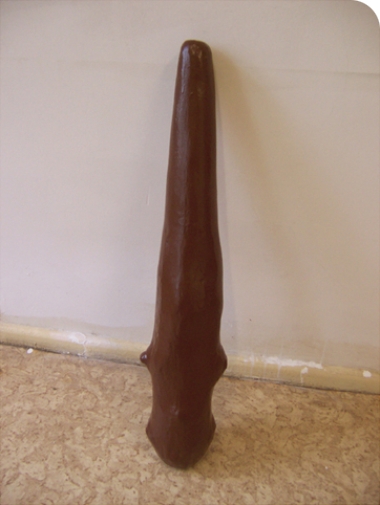 |
| |
 |
| Baldur Geir Bragason |
| Yfirborðskennd - Superficiality |
| 13. 12. 2008 - 18. 01. 2009 |
| |
Superficiality
Baldur Geir Bragason exhibits in Kling & Bang
OPENS SATURDAY 13th OF DECEMBER at 5 pm.
Baldur Geir Bragason´s ambiguous visual world most often revolves around itself.
At the same time that he puts forth gripping things and simple images that have familiar paradigms, they refer first and foremost to the process of the artwork as such. That the artist has made a piece, put it forth and that the viewer sees it. Even though the work may remind you of this or that, the connection is short-lived since the source of the imagery is typically from something banal, e.g. cartoons, movies, video games or comics. That doesn´t mean that the pieces are self-centered in a negative sense, on the contrary, they meet the viewer in their simplicity. However, they focus on what visual art is and on people’s expectations towards it, both that of the artists creating their work and the viewers experiencing it.
Let´s take the chair sculptures as an example, Rocking chair (2007). While the sculptures are reminiscent of rocking chairs, it is obvious that they cannot function as such, fragile and weird as they seem. A person can look for further connection to the phenomenon as a piece of furniture, in a western film where the hero sits and rocks on the porch or in the memory of a grandmother knitting. Both tenuous speculations and the attention is redirected towards the sculptures themselves. They are surprisingly square and destitute of the ability to rock; they stand still in mid swing on edgy basis instead of bows. That way the value of the picture put forth is automatically twisted. The framework consists of stapled and glued sticks of wood, onto which canvas is stretched, shaping a seat and a back. All is then painted in neutral browns. The material, its treatment and the edgy structure refer to the material characteristics of paintings, where canvas is stringed on a square frame. Looking at a painting, the subject often draws the viewer from the piece itself and into an imaginary world. Baldur turns this tendency around, instead of a painting of a rocking chair there is a rocking chair made of painting.
Baldur´s bags, Bags (2008), could derive from a video game, semi unreal with a flat plastic like texture. Just like the rocking chairs they play with the concept of painting. And by the strictest definitions they are a painting, paint on canvas, but the canvas has been glued together in the shape of a bag and then painted. The unfathomable contents then fill them out and give them shape, like the frame strings the canvas. The three-dimensional sculptures are in nature as if painted on a two-dimensional surface, with clear lines, surfaces and forms that are shaped by light and shadow. Baldur has often before put forth containers of some sort, vases, barrels and boxes, all handmade from scratch. Handmade mass production of sorts. The containers are known in context with flowers, oil or other contents but in his work the content is never accounted for.
Perhaps the artist suggests that these containers might be raided and broken to get to the contents, displaying his clubs, Truncheon (2006). Again things are exaggerated, like stylized from Tom & Jerry or The Muppet Show and not likely to serve their suggested purpose. The end seems to justify the means, to expose the deception of visual art, that meaning or content is hidden within the artwork. Baldur does not treat this ideology coldly or with arrogance, which is best demonstrated in the heartiness that he puts into his pieces. He projects the idea that the artist gives a part of himself during his work, making jovial fun of himself. In the video Dawdle (2008) a houseless snail crawls around slowly but the slug’s trait is to leave a slimy trail.
Baldur often starts out with a clear and simple image illustrating the vicissitude of visual art and would probably be a bona fide conceptual artist if he stuck to that image. But during the work process, he abandons the pure idea and embraces the craftsmanship; as all his pieces show, he has an outright interest in surface, texture and colour. In that sense the works are far from being a pure ideological remark and become quite tangible things that exude compulsivness and even fetish. His piece Universal (2004) can be named in this context, some sort of a barrel, painted in a special rusty red and covered with countless band-aids. He also made a few stylized black garbage bags, Garbage (2004), from bookbinding cardboard that he varnished with glossy black paint. Or the hexagon prisms that he meticulously painted with red wine, untitled (2003). These are all works that pretend to be containers for some content, but all the effort is put into the surface of the containers since there was never any intention of providing them with content in the first place. Sceptics might call it empty wrapping, but art history shows that the value of visual art is not imbedded in a pre-given content or subject of the art works as such. It is a conjunction of people, both artists and viewers, at given circumstance in time and space, all of which partake in attributing value to a work of art.
Markús Thór Andrésson
English translation by Hulda Bragadóttir
Kling & Bang gallery
location: Hverfisgata 42 - 101 Reykjavik
Open Thursday-Sunday from 2-6 pm.
e-mail: kob(at)this.is
|
| |
|
| |





|
|
|
|
Grandagarđur 20 - 101 Reykjavík
kob@this.is |
|
